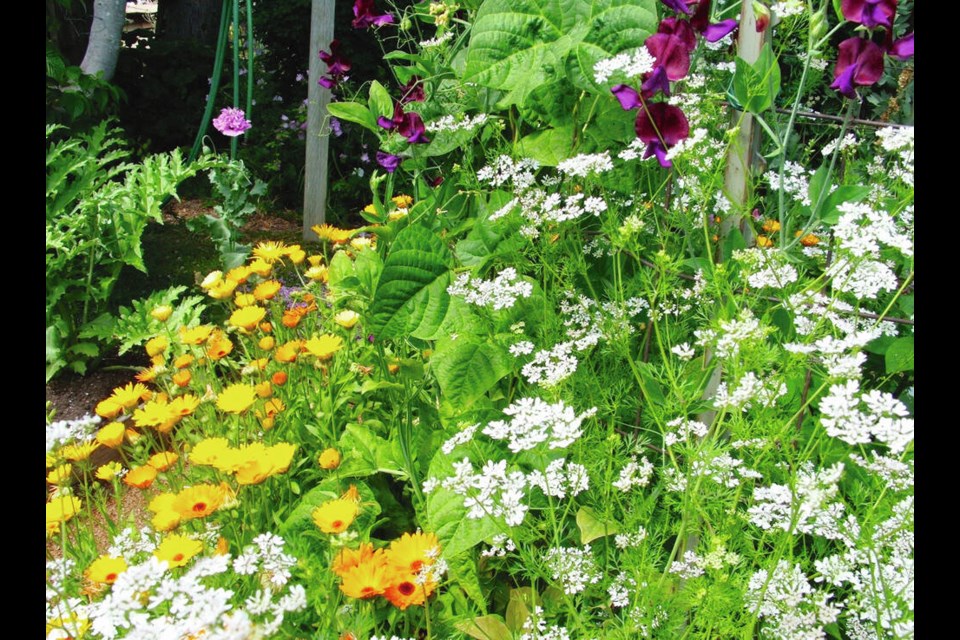It’s that time in the gardening year when keen home gardeners, eager to make a head start on the growing season, are like mother hens clucking with glee over developing seedlings.
I’ve become particularly watchful over the fat, shiny seedlings of an ivy geranium (Pelargonium peltatum). The descriptive term peltatum means shield-shaped, referring to the configuration of the fleshy leaves.
I found the seeds among the flower listings on the Renee’s Garden website. The variety is called “Fancy Pants” and is described as a mixture of “Cascading ivy-leaved plants” that drape softly on 30 to 45 cm stems bearing an abundance of dainty, five-petalled flower clusters in soft cherry, lavender, and creamy white.
I’ve never grown ivy geraniums from seed before. I’ve propagated them, bur from making and rooting cuttings. As with other kinds of cold-tender geraniums (Pelargonium), the cuttings root easily.
As I was considering whether to order Fancy Pants, I thought about what containers I would use for the plants and where I would locate them. From past experience, I know how frustrating it can be to wander around the garden, transplant(s) in hand, trying to find a suitable space for them.
With the ivy geraniums, I lit upon the perfect placement: in two oval containers set in an old hammock slung between two trees. There, the flowering stems can flow freely over the hammock sides and the dappled sunlight will provide a suitable light exposure for the plants. Unlike the far more commonly grown zonal geraniums, ivy geraniums run into trouble in direct, hot sun.
A big part of the excitement in beginning a new gardening season lies in trying new flower and vegetable varieties. From the Renee’s Garden listings I’m also growing a “Hummingbird Salvia” named “Firelight” whose red, coral and white flowers are described as being laden with pollen and nectar to attract, feed and sustain bees, other pollinators, and hummingbirds — the “flowers of the air” — through the summer.
Food and flowers
As early outdoor seedings begin in the food garden, and places for all the vegetables I plan to grow are marked into sites on sketches of my four plots, I’m also noting places along plot edges and at corner spaces for the flowers I consider essential companions to the vegetables.
Flowers add colour and interest to vegetable plots and, chosen carefully, they attract and nurture the many beneficial insects that pollinate our food plants and help to control the insect pests that damage them.
Many of the best flowers to feed beneficial insects self-sow to maintain repeat appearances in the garden. Among these are sweet alyssum, calendula, borage (also called bee bush), cilantro and cosmos.
White sweet alyssum self-sows freely in my vegetable plots. It’s easy enough to simply leave alone the plants that don’t interfere with planned vegetable plantings. Last year, on a whim, I picked up a small flat of an alyssum (Lobularia) called Top Purple and arranged the little transplants along a plot edge. Those plants were amazing, staying neat and flower-filled into November.
I seed cilantro in patches several times over the growing season, and let the plants self-sow for a constant supply of fresh greens, flowers, and seeds to set up the next wave of fresh growth. In bloom, the plants become alive with the movement of hover flies, whose larvae are voracious aphid predators.
Hover flies are usually the first beneficial insects to appear in the spring. The more food the adult flies have, in the form of pollen and nectar, the more eggs they lay. The eggs hatch into the larvae that prey on aphids and other pests.
Simple, single daisy type flowers like most shasta daisies, marguerite daisies sunflowers and calendulas, and some zinnias, give the easiest possible access to the food all sorts of beneficial insects need to flourish and multiply.
Calendulas both self-sow and act as perennials in some gardens. Their cheery flowers brighten a food garden, and the yellow that predominates in the blooms is a powerful attractant for most beneficial insects.
I’m fond of nasturtiums as another brightly coloured flower for edging plots. The blooms’ nectar is exceptionally sweet, attracting hummingbirds and other pollinators. Nasturtiums come in compact, trailing, and vining types. The compact ones are most suitable for edging.



